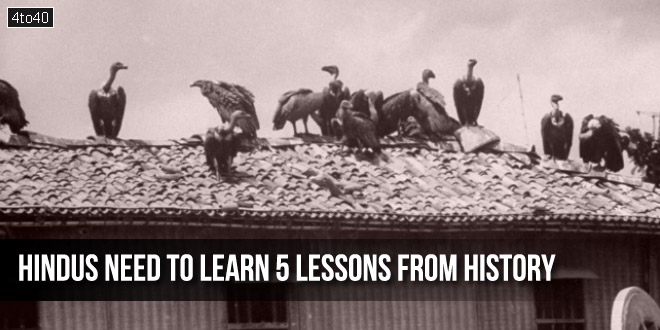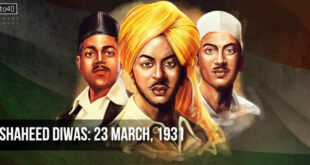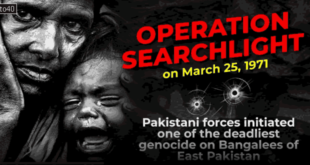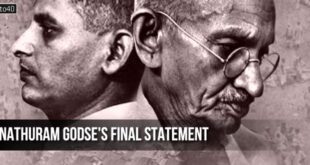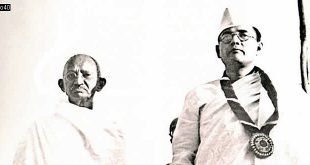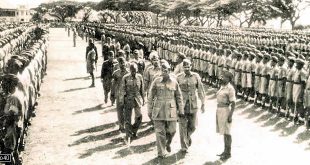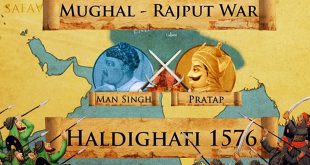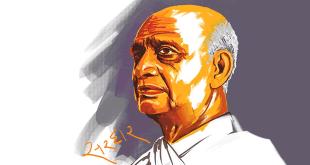As we remember horrors of partition, here is what Hindus need to learn to ensure that Bharat is never torn apart again
The Hindus’ collective right to retain the cultural, religious and ethical integrity of the only land they have has to be held sacrosanct – legislatively, judicially and socially. This is, perhaps, the one lesson that history is screaming out, waiting for Hindus to hear.
Hindus Need To Learn 5 Lessons From History
On the 15th of June 1947, Congress along with Mohandas Karamchand Gandhi accepted the Plan to tear India into two – Islamic Pakistan and Secular India – the horrific effects of which can be felt to this day. Much has been written about the lives lost in the process of Bharat being torn into two and the credit for the lives lost has often been given to Mohammad Ali Jinnah – a man who spearheaded the demand for a separate Islamic state to be carved out of Hindu majority Bharat. However, the root of what led to the partition is often pushed under the rug, because one of the consequences of our leaders actively skirting a full population exchange in 1947 is that an honest conversation about the ideology which led to the partition is often considered taboo.
While individuals are often the medium for change – good or bad – if one needs to honestly evaluate what leads those individuals to change the course of history – one has to honestly and truly analyse the belief that led them to do what they did. In the case of the partition of India, talking about the actions of Jinnah is far from being sufficient if one wants to truly understand what led to the partition and the dangers that face India to this date. What drove Jinnah to spearhead a campaign to tear Bharat apart was Islam and the inherent separatism embedded in the religious doctrine of Islam. The logical extension of that argument is that while the partition of India took place 75 years ago, given that India chose to be a ‘secular nation’ with no full population exchange at the time, the dangers of Muslim separatism continue to haunt India.
LIFE Magazine Images of ‘Direct Action Day’It is said that there is no better teacher than history in determining the future. While the conversation around the Partition of India has mostly been partially dishonest and wholly myopic, it becomes imperative, as we stand today at the cusp of Khilafat 2.0, to draw lessons from history. If one truly looks at historical facts, leaders had almost a century to truly understand the perils of Muslim separatism, what causes it, and the inevitable tactics that would be deployed by Muslim leaders to eventually tear Bharat apart. That we failed to draw lessons then led to a blood-soaked, cataclysmic blunder then, is a lesson in itself – a lesson to ensure that empirical truths are acknowledged and understood before we stand at the edge of Partition 2.0.
Acknowledging the inherent two-nation theory embedded in Islamic theology
The discussion on partition often revolves around Mohammad Ali Jinnah, the British and the evil plans of that alliance, however, Jinnah was not the first person to propaganda the idea of the two-nation theory – a theory that essentially says that Hindus and Muslims cannot live in the same country because the Muslims are a nation unto themselves. Their culture, ideology, religiosity, ways and means of living their lives, beliefs and the code they live by is so different and set in stone from those of the Hindus, that co-existence is an impossibility.
One has to realise that the very concept of the two-nation theory is based on Islamic theology. Even if one does not delve into theology, the very definition of the two-nation theory separates Muslims from non-Muslims on the basis of their faith. To understand how Jinnah was not the first to propagate the two-nation theory and how Muslim separatism is embedded in Islamic theology, we must evaluate what others had said about Muslim separatism much before Jinnah.
In 1876, Syed Ahmad Khan, the founder of Aligarh Muslim University, said that Hindus and Muslims could never become one nation as their religion and way of life were quite distinct. Twelve years later, he said, “Now, suppose that the English community and the army were to leave India, taking with them all their cannons and their splendid weapons and all else, who then would be the rulers of India?… Is it possible that under these circumstances two nations—the Mohammedans and the Hindus—could sit on the same throne and remain equal in power? Most certainly not. It is necessary that one of them should conquer the other. To hope that both could remain equal is to desire the impossible and the inconceivable. But until one nation has conquered the other and made it obedient, peace cannot reign in the land.”
While Khan spoke in the context of India specifically, the nature of Muslim separatism was not new and was certainly not an alien concept that anyone who was willing, to be honest, could not see for themselves. Karl Marx, the Father of Communism, stated in 1854, “The Koran and the Mussulman legislation emanating from it reduce the geography and ethnography of the various people to the simple and convenient distinction of two nations and of two countries; those of the Faithful and of the Infidels. The Infidel is “Harby,” i.e. the enemy. Islamism proscribes the nation of the Infidels, constituting a state of permanent hostility between the Mussulman and the unbeliever.”
It was only in 1940 that Jinnah formally announced the demand for a separate Muslim nation. At the 1940 Muslim League conference in Lahore Jinnah said: “Hindus and the Muslims belong to two different religions, philosophies, social customs and literature… It is quite clear that Hindus and Muslims derive their inspiration from different sources of history. They have different epics, different heroes and different episodes… To yoke together two such nations under a single state, one as a numerical minority and the other as a majority must lead to growing discontent and final destruction of any fabric that may be so built up for the government of such a state.”
Essentially, while Jinnah only made the formal demand in 1940, the verbalisation of Muslim separatism had taken place much before that – almost 70 years ago by the founder of AMU. Even the argument that both these individuals spoke in the specific context of India and therefore, the concept of separatism cannot be extended to Islamic theology falls flat since before Syed Ahmad Khan, Marx had already spoken extensively about how Muslims are incapable of surviving with non-Muslims because their very faith reduces people to two nations – those of the faithful and those of the Infidels.
Islamic theology, in itself, is based on this strict distinction between believers (of Islam) and Kafirs (non-believers). When the doctrine itself mandates the believers to slay the infidels and turn Dar-Ul-Harb (the Land of the non-believers) into Dar-Ul-Islam (the land of the pure), one has to acknowledge that the partition was not necessarily an India-centric and India-specific problem but one that emanates from Islamic theology – one that is a threat even today.
There are at least 26 verses in the Quran as pointed out by an erstwhile Muslim himself that talk about waging a battle against disbelievers (Kafirs). When the Islamic theology itself is based on the premise that Muslims are supposed to wage a war against non-Muslims (Hindus in this case) until they are killed, converted or driven out of their land (to make Dar-Ul-Harb into Dar-Ul-Islam) it is an exercise in naïveté to believe that the two-nation theory was specific to India and limited to the age of the struggle for India’s freedom.
Unless the theological roots of the two-nation theory are not acknowledged and accepted, Bharat as a modern nation-state would always be caught off-guard, like it was in 1946, into carving out pieces of itself to satiate the insatiable appetite of the believers to cast Kafirs into hell-fire and turn Bharat into a Muslim nation. This theory is proved by the fact that over 70 years after the partition of India, while our lawmakers believe that we have managed to achieve a nation where general brotherhood between Hindus and Muslims exists as a norm, we saw the rise of organisations like the Popular Front of India (PFI) which vowed to turn India into an Islamic state, convert Hindus and even commit genocide of the Kafirs in their holy war. One must ask the question today – as we remember the horrors of the partition – that if the partition of India on the basis of religion was time and geography-specific why does India with one of the largest Muslim populations in the world see the rise of Muslim separatism repeatedly? If the two-nation theory is not embedded in the Islamic doctrine, and if those fighting for a land of the pure are not following “true Islam”, as is the favourite punchline of secularists, why is it that the same principle is repeated in the name of the same doctrine across centuries, across geographies and across situations?
Are the Muslims of Thailand fighting for an independent Muslim south Thailand, Muslim separatist groups in the Philippines, the East Turkistan movement in China, the Palestinian terrorism problem, the Rohingyas fighting against the Buddhists for Rakhine and the endless list of separatist and terrorist movements fighting either for independent Muslim states of fighting internally and globally against the Kafirs, all not following the “real Islam”? Unless this harsh global reality is acknowledged, understood and remedied, Bharat – the last standing, surviving, home of polytheism will perhaps fall like it did once, only to realise that another genocide of its indigenous Hindu people could have been avoided with a little honesty and study of history.
Realising that Muslim victimhood is a stepping stone to separatism
When one thinks of the partition, the predominant theme that is often eulogised is that it was a human tragedy with several lives lost – the lives of Hindus and Muslims. Mainly, one remembers those horrific pictures of trains with people perched on top of it while crossing the newly formed border between India and Pakistan. We are told that post-partition, Hindus were killing Muslims in India while Muslims were killing Hindus and Sikhs in Pakistan. All of that is true. There is no contestation to the fact that the lives of Hindus and Muslims were both lost due to a partition of which, the foundation was Islamic theology. However, apart from the actual partition and the lives lost thereof, there were several instances in the century leading up to the partition that formed the foundation of the mindset which allowed the country to be torn apart.
It was essentially the same pattern that we see today – Muslims kill Hindus because they are waging a war against Kafirs – Hindus, after being killed, murdered, beheaded and raped, eventually and somewhat meekly decide to defend themselves – once they start defending themselves, the Muslims play the victim – once they start playing victim they say that they feel unsafe because Hindus are in majority – the leaders of the time (then and now) start pandering to the ever so fearful Muslims forgetting how it was them who were the aggressors – Hindus are then blamed for making Muslims feel unsafe – born out of that feeling of being “unsafe”, Muslims say that they are unable to live with the terrible Hindus and deserve a separate land for themselves where they can feel secure. The entire existence of Bharat has been about oscillating in this cycle, one way or another, then and now.
Just a few examples where Hindus were subjugated by the Muslims and the events that followed would substantiate the preceding supposition. In this regard, it would bode well to remember the case of Mahashay Rajpal, who published Rangeela Rasool and was ultimately assassinated for it. We mostly hear that Mahashay Rajpal was assassinated for publishing satirical work on Prophet Muhammad called Rangeela Rasool, but we seldom hear why he chose to publish the book. In 1923, Muslims published two particularly offensive books to Hindus. “Krishna teri geeta jalani padegi” used derogatory and vulgar language against Shri Krishna and other Hindu deities and “Uniseevi sadi ka maharshi” which contained derogatory remarks on Arya Samaj founder Swami Dayanand Saraswati (incidentally written by an Ahmadi). It was in response to these two books by the Muslims that Mahashay Rajpal published Rangeela Rasool. The Muslims, after the publication of Rangeela Rasool went on a rampage. MK Gandhi along with several other leaders condemned Mahashay Rajpal for publishing a book that offended the sensibilities of Muslims. No mention was made of the aggression that was initiated by the Muslims. No mention was made of the two offending books which were published by the Muslims. Ultimately, the British, to pacify the ever-enraged Muslims, passed 295A. That, however, was not sufficient. The Muslims, playing the victim and touting their hurt sentiments, murdered Mahashay Rajpal. The assassin, Ilm ud Din, was hailed by Jinnah and Iqbal – those who ultimately demanded the partition of India.
In 1946, the massacre of Hindus in Bengal was rather intricately planned. Jinnah is recalled having said that he will either have India divided or India burnt and that he had given up on Constitutional methods to demand the creation of Pakistan. Jinnah had chosen the 16th of August as Direction Action Day because it was the 18th day of Ramzan, the day when the Battle of Badr was fought and won – a war fought by Prophet Muhammad himself, against the Kaffirs, and is considered to be won by Allah’s divine intervention by Muslims. The battle led to the violent occupation of Mecca.
On the 16th of August, Calcutta was littered with posters lionising Jinnah and reminding Muslims that they had to follow in the footsteps of the Prophet. It is reported that Syed Muhammad Usman, mayor of Calcutta, had issued a widely circulated leaflet that said: Kafer! Toder dhongsher aar deri nei! Sarbik hotyakando ghotbei! (Infidels! Your end is not far away! You will be massacred!). The aim was to make Bengal ‘land of the pure’ and rid it of the Kaffirs (Hindus). The aim was to wage another Battle of Badr, in which the Muslims would conquer the heathens.
After thousands of Hindus were beheaded and raped, two days later, Gopal Patha picked up his weapons and started defending his brethren. Muslim League chief minister of Bengal, Huseyn Shaheed Suhrawardy and the Muslim League goons had decided on the 17th that they were going to take two more days to complete the annihilation of Hindus. But they had not taken into consideration their greatest roadblock. Gopal Patha.
From the 18th to the 20th, Gopal Patha and his men put up a brave fight, paying the Muslim League goons back in equal measure, if not more. Historian Sandip Bandopadhyay wrote, “They faced resistance everywhere. Hindu youths counter-attacked with such ferocity that the Muslim League men had to flee. Many were killed. Emboldened by their success in taking on and defeating their Islamist attackers, Hindu youths took the fight to Muslim-majority areas and started killing Islamist men. They did not, however, touch Muslim women and children or the aged and the infirm“.
By the 19th of August, suddenly, the Muslims started feeling unsafe. Only two days of retribution, of self-defence, and the Muslim League started running with their tail between their legs. It was only on the 21st of August when the Muslims had started feeling unsafe because the Hindus dared to defend themselves, did Viceroy’s rule come into action in Bengal.
Mohandas Karamchand Gandhi asked Gopal Patha to lay down his weapons so the Muslims could start feeling safe again – because the ever-oppressed Muslims deserve to feel safe even after beheading and raping thousands. Gopal Patha refused. But, the pattern was evident – Muslims kill Hindus. Hindus defend after thousands of them are killed. Hindus get blamed for making Muslims feel unsafe. Muslims demand a separate nation because they can’t live with Hindus who are by then, branded as the original aggressors merely for defending themselves.
https://www.youtube.com/watch?v=IaL8mvqxNxg
This Muslim victimhood that we see today too, follows exactly the same pattern that it did then. Let’s take the example of the recent Nuh violence. Islamists unilaterally and brutally attacked a Hindu religious procession in Nuh. They held hostage several thousand devotees in a temple. Killed multiple Hindus. Rained bullets, petrol bombs and stones. Celebrated the brutal hacking of Hindus. And then, after the unilateral violence was unleashed, played victims when the government started bulldozing the homes of rioters and the perpetrators started getting arrested. Ultimately, the global media and the Jihadi media at home painted Hindus as the aggressors and Muslims as the victims.
Now, given what we see today follows the same pattern that we saw in the run-up to the partition, one has to wonder where we are going to be if we don’t draw lessons from what happened then. If the Muslim victimhood after unilateral violence is unleashed by them is indulged now as it was then, how long would it be before they claim another partition of India because they perpetually feel unsafe with the terrible Hindus who just won’t die as they want, without having the temerity to defend themselves?
Every Hindu murdered for being Hindu because of the Islamic doctrine is a brick that paves the way for partition
Often, cataclysmic events are the culmination of smaller events that lead to a tectonic shift. When we delve into history and historical blunders in great detail, we are often told that what happened in the past must remain in the past and should not affect how one deals with the current offshoots of the same ideology – in the name of brotherhood and unity, of course. There is no point discussing the ideology that led to the partition of India because the Indian Muslims today are different from those who demanded a separate nation then, we are told. There is no point talking about the regular murders of Hindus by Islamists owing to their religious doctrine because it sows the seed of division in society leading up to the Muslim population feeling unsafe – because those who murder are just murderers – not followers of Islam, we are told.
I have no qualms in believing that all Muslims are not the same. I wholeheartedly accept that even when Bharat was torn apart on the basis of Islamic theology, there were Muslims who wanted to see the integrity of Bharat Mata preserved – who thought of themselves as Bharatiya and not just Muslims. While that was a truth then and is a truth now, the partition did happen on the basis of religion. While that was a truth then as is a truth now, Hindus are being murdered on a regular basis merely because they are Hindus and deemed “Kafirs” by Islamists.
Talking about history and drawing lessons for it cannot be skirted simply because the fragile feelings of a few would be hurt because the truth is a bitter pill to swallow. Often, when one says that the threat of a second partition never truly dispersed from the skies of Bharat, one imagines a cataclysmic event leading to another cataclysmic event. One perhaps believes that only an equivalent of a Malabar Genocide of Hindus or a Naokhali Genocide would be a marker that we stand at the cusp of separation. However, history proves that is untrue.
Every Hindu murdered in Bharat for being a Hindu by an Islamist who carries out that murder/attack by virtue of being a follower of Islam is a brick, building the road that leads to another separation. When Mahashay Rajpal was murdered then, even though it was right after the Malabar Genocide of Hindus, nobody truly imagined that a Naokhali Genocide would happen. Nobody also imagined that Iqbal, who hailed the murderer of Mahashay Rajpal, would be hailed today as a patriot. When Mahashay Rajpal was murdered and Jinnah defended Ilm-u-Din, nobody imagined that a decade later, it would be he who would launch a formal demand for Pakistan and certainly, nobody imagine that almost over 100 years later, we would see blasphemy killings and beheadings take place in India even after Muslims carved a land where they would supposedly feel secure.
Every Hindu that is killed for being a Hindu is killed by those Muslims who believe that they are waging a war against Kafirs and are in the quest for a land where Sharia will reign supreme. Every Islamist is a Ilm-u-Din in the making and every moderate is a Jinnah in the making – I say this with utmost responsibility since even Jinnah is often touted as one – the man who ate pork and drank alcohol.
Every Kanhaiya Lal takes us closer to the demands for a separate nation because after every Kanhaiya Lal, the victim is forgotten and what is remembered eternally is that the ire of the Hindu after a Kanhaiya is beheaded will make the Muslim community feel insecure. Unless the Hindu society refuses to get desensitised to the killing of their own and truly realise the dangers of such communal onslaughts, history might not only remain etched in black and white.
Giving concessions in the name of religious freedom and sentiment
There have recently been several attacks against Hindu processions by Muslim mobs. In 2022, there was a spate of attacks against Ram Navami attacks in India. Several Hindus came under the onslaught of Islamic violence with stones being pelted from mosques and rooftops, guns being fired and more. Almost immediately, the reason that was given by the Jihadi media in India was that it was the fault of the Hindus because they dared to take their religious procession out from an area they deemed a “Muslim area”. According to them, the fact that Hindus took out their religious procession from an area where the Muslim population was substantial, hurt their religious sentiments and ultimately, the mere existence of the Hindus chanting Jai Shree Ram provoked them to commit violence against the Hindus. This was then used as a justification for the violence eventually blaming the Hindus for their own persecution.
In almost every age, the fact that Muslims seem to have sentiments that require special concessions to be preserved seems to be a given that the State and the Hindu community have almost internalised. Christopher Hitchens once said, “It is very clear to me that the most toxic form that religion takes is that of Islam. All religions claim to reveal the truth, but Islam rather dangerously says ours is the last and final one. There can’t be any more after this. Now, that is straightaway a temptation to violence”.
And that is truly at the crux of why religious processions come under attack when Muslims find themselves in substantial numbers in an area. Essentially, theologically, Islam is antithetical to the existence of any other religion and therefore, any religious procession in itself is a religious affront to their faith.
That this is a theological issue and not a recent political one is again proved by historical evidence.
1923 onwards, communal riots were an order of the day especially after the Hindus had started a shuddhi movement which was condemned by the Muslims, who were regularly converting Hindus by force at the time. In 1918, given the discord between Hindus and Muslims, a committee had been appointed at the Delhi session of Congress to draw up an “Indian National Pact”. A draft of the pact was placed before the committee in 1923. In the meantime, the Bengal Provincial Congress Committee, under the direction of CR Das, approved a strange “Hindu Muslim Pact”, specific to Bengal, that essentially curbed the rights of Hindus. Even in this pact, the “music in front of Mosques” played a prominent role.
Two features of the pact, which was later rejected by the Congress committee, as was the National Pact, need to be analysed specifically.
- No music should be allowed before a mosque
- There should be no interference with cow killing for religious sacrifices, but the cow should be killed in such a manner as to not wound the religious feelings of Hindus.
While no music in front of a mosque is something that the Muslim side specifically demanded, they also demanded their right to slaughter cows. The fact that the pact said that the manner of killing should not offend Hindus, it is pertinent to realise that any slaughter of cows would hurt the religious feelings of Hindus, regardless of the method adopted.
While this Pact was rejected later, it goes to show this history of attacks against Hindus because of the establishment of so-called “Muslim areas” where even music being played by Hindus invited violence from the Islamists.
RC Majumdar in his book then talks about incidents of violence that marred the period, with many of them revolving around music being played in front of mosques and Hindu religious processions being taken out from “Muslim areas”.
Mr Majumdar writes, “One of the worst communal riots broke out in Calcutta in May 1923. It arose out of an Arya-Samajist procession playing music while passing before a mosque. The Arya Samajists contended that they were merely following a regular practice which was never objected to before, while the Muslims asserted that the music disturbed their religious prayer. So fighting commenced and continued for several days, in the course of which there were many casualties on both sides”.
Therefore, the concessions that are demanded by the Muslim community in the name of religious freedom and hurt have always been and perhaps, will always be not about their right to practice their religion, but about establishing their religious supremacy over religions that they are theologically opposed to.
While in any functioning democracy, every individual should have the right to practice his religious in the confines of his home and place of worship, that right cannot be held sacrosanct when it a) infringes upon the rights of others b) demands constant concessions from other religions in the name of hurt sentiments.
Attacks against religious procession is just one thread of a larger problem. Whether it is the demand for the Hijab to supersede school uniforms, the opposition to Uniform Civil Code (made in 1947 as well with Muslim sentiments prevailing as always), the insistence on conducting namaz in public places to assert their religious supremacy to their demand for a law protecting them from “Islamophobia”, it is all aimed at demanding concessions, chipping away at the very fabric of the nation.
Historically, the Islamists were emboldened when the community as a whole were given endless concessions – whether it was participation and endorsement of the Khilafat movement, legislative reform in personal law being skirted or the places of worship act which denied Hindus their historic right to their places of worship. While every individual has the right to worship, collectively, the nation would have to decide if one community’s right to be offended is above the right to life and peaceful worship of another.
Pandering to leaders such as those of the Khilafat movement
The Khilafat movement is perhaps the template that would be repeated if Bharat does not learn from history. The first Khilafat Conference was held in Delhi on November 22-24, 1919. More than half the delegates at this conference were from today’s Uttar Pradesh. In this conference, resolutions were passed to stay away from victory celebrations, boycott British goods and send a delegation to England to find a just solution to the Khilafat. Leaders like Mohammed and Shaukat Ali brothers, Maulana Abul Kalam Azad and Dr Ali, Hasrat Mohani emerged from this conference. On 24th November, MK Gandhi, at a well-publicised joint Hindu-Muslim conference, announced that Hindus were united with Muslims in their grievances over the Caliphate because it was a just cause.
Motilal Nehru, in his presidential address on 27th December, strongly condemned the Jallianwala Bagh massacre but he also condemned the partition of the Ottoman Empire. He said, “It is impossible for one part of the nation to stand aloof while the other part is suffering from a serious grievance.” In Resolution XV on the issue of Khilafat, the Congress urged his Majesty’s government to settle the Turkish question in accordance with the just and legitimate sentiments of Indian Mussalmans and the solemn pledges of the Prime Minister without which there will be no real contentment among the people of India.
At the Nagpur session on December 1920, the Congress gave the British a deadline of one year to meet its demands on the Jallianwala Baug massacre and the Khilafat and warned of a nationwide non-cooperation movement. MK Gandhi assured civil disobedience. At the annual session of the Congress in 1920 in Nagpur, the Khilafat leaders read Quranic verses that call for Jihad and support the killing of Kafirs (non-believers). When it was pointed out to MK Gandhi, he smiled and said: “They are alluding to the British bureaucracy”. While Gandhi and Nehru shut their eyes, the outrages by Moplah Muslims against Hindus continued and the Ali Brothers gave a violent call to jihad as a part of the non-cooperation movement.
As MK Gandhi, Nehru and other leaders of the Congress shut their eyes to the blatant calls for Jihad against Hindus as a part of the Khilafat movement, a movement which had nothing to do with Indians and India’s independence, after hundreds of incidents of low-level violence against Hindus by the Moplah Muslims of Malabar, in August 1921 over 10,000 Hindus were mercilessly killed. A large number of women were raped, temples were vandalized, people’s homes were burnt and they were banished. There were many incidents of burning people alive and peeling their skins, people were asked to dig graves for themselves and were buried in them.
From BR Ambedkar to Annie Besant spoke about the hideous atrocities that were heaped against the Hindus during the Malabar genocide of Hindus, a genocide that was 100 years in the making.
While the genocide of Hindus took place, MK Gandhi, yet again to appease the Muslim leaders of the Khilafat movement essentially put the onus of peace on Hindus. He told Hindus that the Muslims were killing Hindus in Malabar because the Hindus had not made the Muslims feel like brothers.
Gandhi said, “If the Mussalmans of India offer non-cooperation to the Government in order to secure justice on the Khilafat, it is the duty of every Hindu to co-operate with their Moslem brethren”. It is to be kept in mind that this speech was made in August 1920 when the Muslims had already started to massacre Hindus in their demand to establish a caliphate and in their support for the caliphate in Turkey – while Hindus died, Gandhi asked Hindus to participate in the very movement that was leading to genocide, simply to appease the Muslim leaders of the Khilafat movement.
Historian RC Majumdar in his seminal book “Struggle For Freedom” writes, “The so-called Nationalist Muslims who had joined Gandhi in the anti-British crusade of 1921 were really pan-Islamists who merely exploited Gandhi for securing redress of the Khilafat wrong. As soon as the Khilafat agitation came to an ignoble end after the abolition of the office of the Caliph by Kemal Pasha in 1924, most of these Muslims, including the Ali Brothers, whom Gandhi identified with his cause, appeared in their true colours. Muhammad Ali, who was the principal lieutenant of Gandhi in his first Satyagraha campaign in 1920, refused to join him in the second campaign in 1930. At a meeting of the All-India Muslim Conference in Bombay held in April 1930, attended by over 20,000 Muslims, he bluntly stated: “We refuse to join Mr. (no longer Mahatma) Gandhi because his movement is not a movement for the complete independence of India but for making the seventy millions of Indian Musalmans dependants of the Hindu Mahasabha”. He made no secret of the fact that the Muslims, as a whole, were guided by Pan-Islamism. He told the members of the Round Table Conference: “Islam was not confined to India. I belong to two circles of equal size but which are not concentric. One is India and the other is the Muslim World…. We are not nationalists but super-nationalists.”2 In his address as Congress President in 1923 he reminded the audience that “extra-territorial sympathies are part of the quintessence of Islam”.
I reiterate what Muhammad Ali, the leader of the Khilafat movement and MK Gandhi’s trusted “nationalist Muslim” said – “Extra-territorial sympathies are part of the quintessence of Islam”.
While MK Gandhi trusted a “nationalist Muslim” and branded the Khilafat movement as a part of the freedom struggle against the British (the Left historians still wish to peddle that the Khilafat movement was a nationalist, freedom movement), the Nationalist Muslim who spearheaded the Khilafat movement clearly denounced Gandhi and India, to say that the Muslim’s loyalties ‘extra territorial’ since they are a part of the Muslim world.
Gandhi and other Congress leaders sacrificed the lives of thousands of Hindus, kept quiet about the massacre of Hindus by Muslims, forced Hindus to support a movement which was for the benefit of the Muslim world leading to their own genocide, pandered to them to fulfil their demands, essentially, they later got spat in their face because they refused to acknowledge simple realities. They closed their eyes even when calls for killing Kafirs were being made as they extended support to the Khilafat movement.
Today, there are several political alliances and schemes which are aimed at ensuring the welfare of Muslims. While that is all well and good, the fact that Hindus are forced to live under the notion that all Indian Muslims are “Nationalist Muslims” only gives rise to the possibility that while we sleep under the comfortable blanket of brotherhood, a Muhammad Ali will spearhead a 100-year long path to another genocide of Hindus, under the garb of nationalism, only to later claim that his loyalties are extraterritorial.
Conclusion:
I come back to a statement I had started with – there is no better teacher than history in determining the future. History shows that progressively, a violent minority has strengthened the legislative, judicial and societal cover it gets to assert its religious supremacy aspirations. These aspirations are often negotiated after a violent, vehement and shameless assertion of street veto. The State and leaders who are meant to protect Bharat have bent a knee to the street veto and tried their damndest to assuage the perennially offended, the often violent and the perpetually demanding lot. Their constitutional special status keeps getting reaffirmed either by politicians or the judiciary in the hopes that the ever-so-offended lot will not take to the streets and indulge in rampant violence which the state is woefully incapable of controlling simply to prove just how downtrodden and oppressed they truly are.
The intolerant minority has often held a sword to Bharat’s neck and forced her to concede that she has oppressed the sword-wielders.
I have no hesitation in saying that Bharat is somewhere in the 100 years which preceded the Malabar genocide of Hindus, soon after which, Bharat was torn apart. When Bharat pandered to the sword-wielders and their supremacist demands, she was mercilessly broken in two – losing millions of her sons and daughters. The question that we collectively need to answer now is what can be done to ensure that the progression is arrested.
India is the only land that has a Hindu majority. Hinduism, Sanatan, is engraved in its consciousness since before the political boundaries were drawn. Our stories, our heroes our legacy is attached to this land and no other. It is a fact that while even the most “extreme” Hindu’s crime is saying that this is a Hindu land – taking ownership of this civilisation and vowing to preserve it – the most extreme Muslim has a completely opposite view. He believes that India is Dar-ul-Harb which must be converted to Dar-Ul-Islam. When such notions are harboured, there is obviously no allegiance to the Constitution and it is precisely the sovereignty and integrity of the nation that they wish to hurt – as it was during the brutal partition of the nation.
A strong, confident, sovereign Hindu India is perhaps the only thing that has the potential to stop the balkanisation of Bharat. A Hindu nation, built on Hindu ethos where every citizen, including Muslims, has equal rights but Abrahamic religious supremacy is not pandered to, but rather, prosecuted by the law. In order to do that, there are two elements that have to be asserted – one by the State and the other by Hindus.
The State has to ensure that it has the ultimate and final monopoly on violence. Any attempts at an Abrahamic religious insurrection have to be quelled with an iron fist and brute force without repeating the mistakes of MK Gandhi, pandering to those who wear the masks of being “Nationalist Muslims” or “Moderate Muslims”, which supporting the supremacist aspirations. The people, on the other hand, need to with pride where the responsibility of preserving the Hindu character of Bharat. Hindutva was meant to arm Hinduism to adapt to a world order based on nation-states. A concept which for Muslims means Ummah and for Hindus meant this civilisational state. Hindus gave up their Monarchs to get “secularism” and they needed Hindutva to find their political identity. Hindutva is meant as a shield against those who weaponise the innocence of Hindus and because they needed to weaponise the innocence of Hindus, Hindutva had to be tarnished by the Ummah and the Global Left Conglomerate.
The Hindus’ collective right to retain the cultural, religious and ethical integrity of the only land they have has to be held sacrosanct – legislatively, judicially and socially. This is, perhaps, the one lesson that history is screaming out, waiting for Hindus to hear.
 Kids Portal For Parents India Kids Network
Kids Portal For Parents India Kids Network
